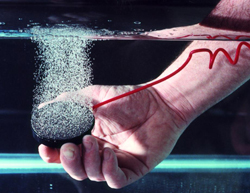Air bearings are not a new technology, but they may be a technology whose time has come. That’s because air bearings strike at the very heart of the environmental problem of oil lubrication.
In the past, air bearings were not commercially available. They have been a do-it-yourself technology, used in special machine tool applications in defense and nuclear energy industries. Improvements in air bearing technology and increased availability have conspired to make them both a practical consideration for broad industrial applications and an easy component for design engineers to incorporate.

 The original New Way Air Bearings flat, round air bearing product line ia modular, easy-to-use, and available off-the-shelf.
The original New Way Air Bearings flat, round air bearing product line ia modular, easy-to-use, and available off-the-shelf.
Modular air bearings are now available as flat gimbaled mounted pads and as self-aligning bushings. Both designs are cost competitive with rolling element bearings and, in many cases, the air bushings are directly interchangeable with ball-type bushings.

Air bearings are exceptionally clean because they don’t use oil. In fact, they are the cleanest type of bearing. Because their surfaces do not touch, no particles are generated by mechanical wear. Air bearings are popular in semiconductor manufacturing cleanrooms for this reason, as well as their ultra precision capabilities. When overlays in lithography applications are measured in tens of nanometers, the zero static fraction of air bearings allows for ultra fine adjustments.
Coordinate measuring machines (CMMs) are a common application for air bearings. Even in metal cutting machine tools, air bearings hold the lead in ultra precision work. Diamond turning machines use diamond tipped tooling and air bearing guide ways to produce mirror surface finishes and flatnesses measured in fractions of a wavelength of light.
Another successful air bearing application is dry diamond machining, which is becoming popular in Europe because it is so environmentally friendly. Dry diamond machining with high-speed air bearing spindles results in chips almost like dust, in contrast to coolant-contaminated metal chips that become a hazardous and expensive waste. The dry diamond machining dust can be collected by vacuum and the non-hazardous scrap can be sold.
Air bearings have the advantage in this dry environment. As dust mixes with oil, an abrasive slurry is created that is difficult to keep out of bearing elements. With air bearings, the ways stay dry and the dust is blown away by the air pressure exiting the edge of the bearing.
Accuracy and environmental advantages, combined with increased availability and falling cost, should lead to air bearings appearing in a broader range of future applications. This is likely to be especially true with improved porous media bearings, now available in standard sizes.
by Drew Devitt
Founder, Chairman and Chief Technology Officer New Way Air Bearings Aston, Pennsylvania, USA

